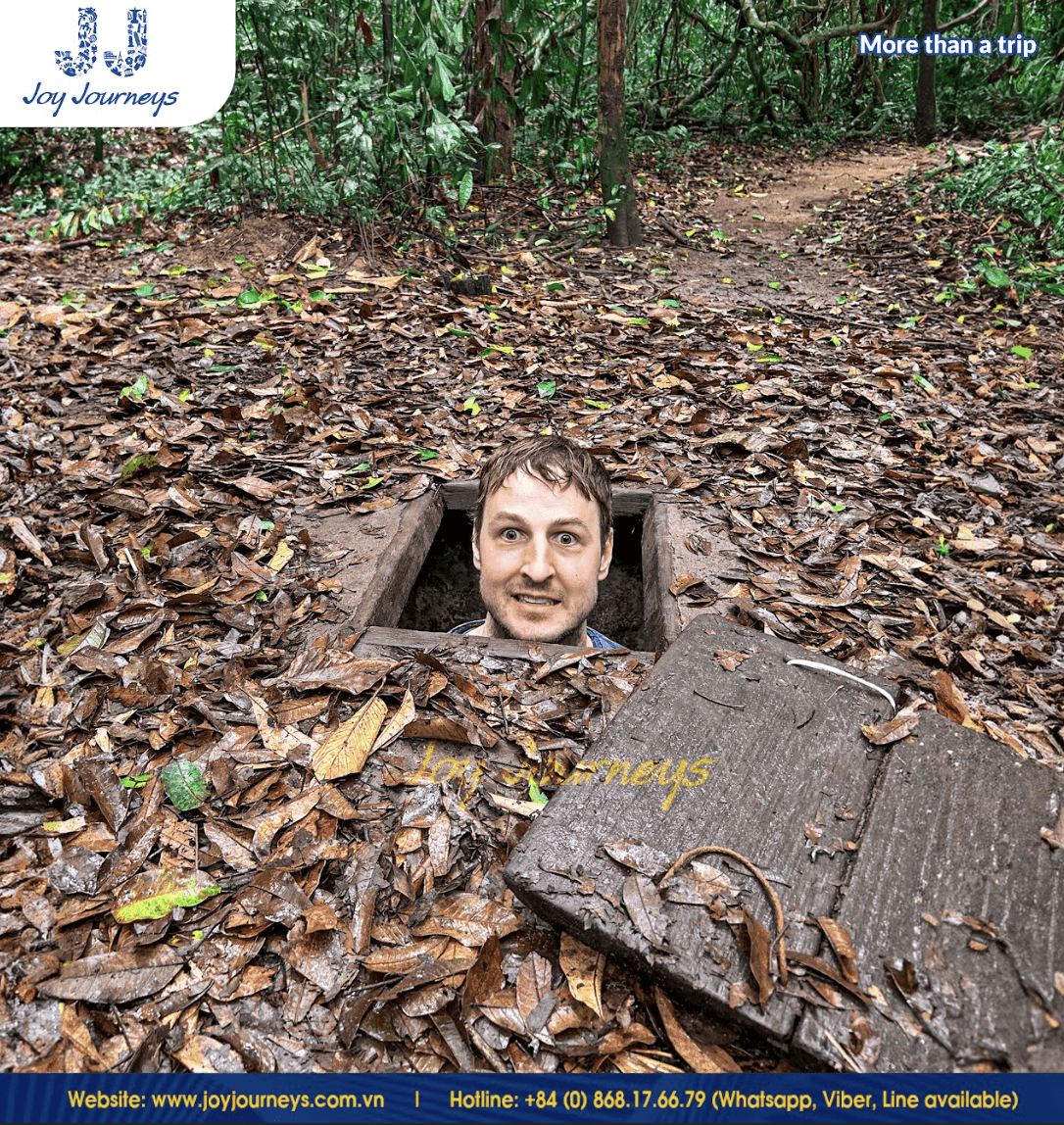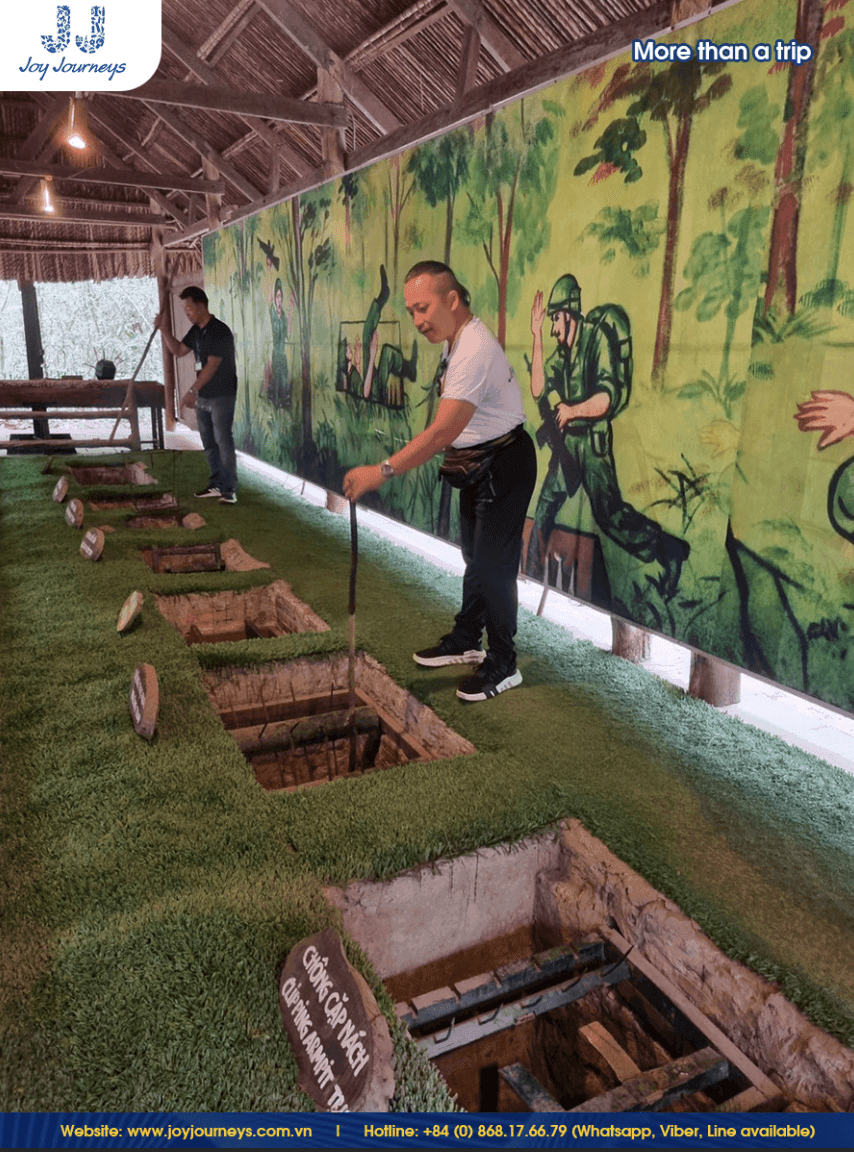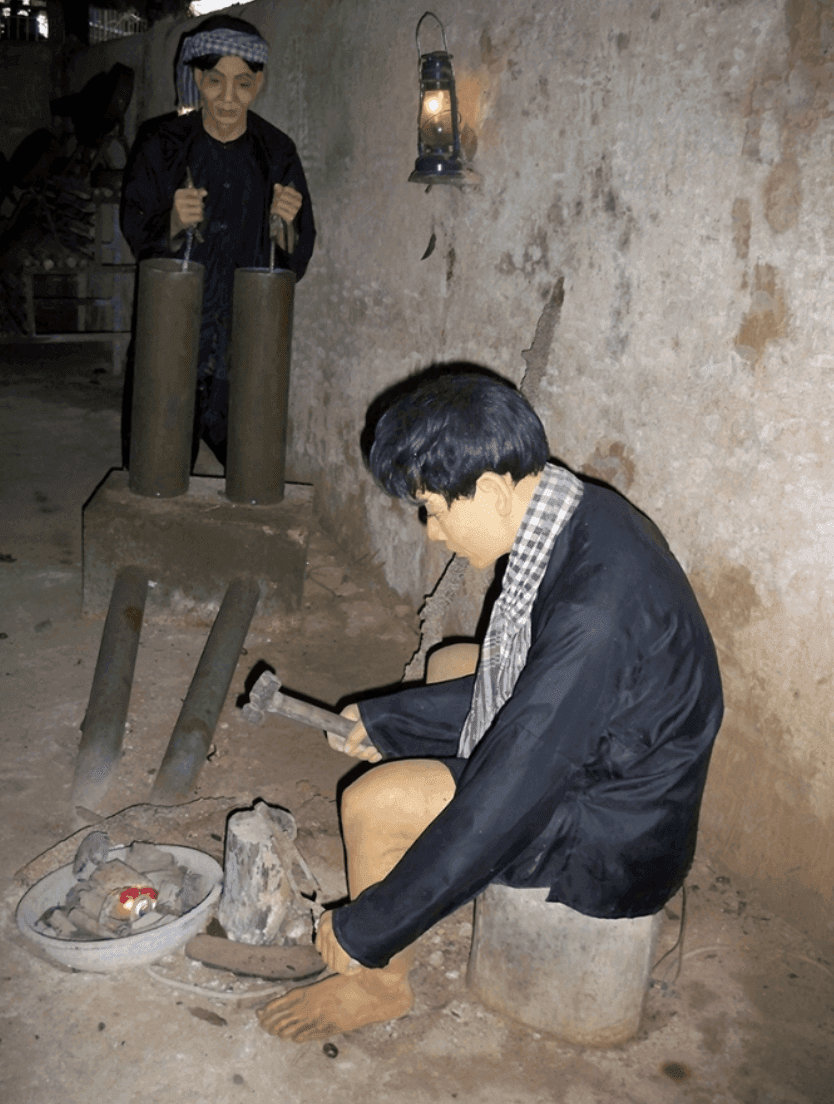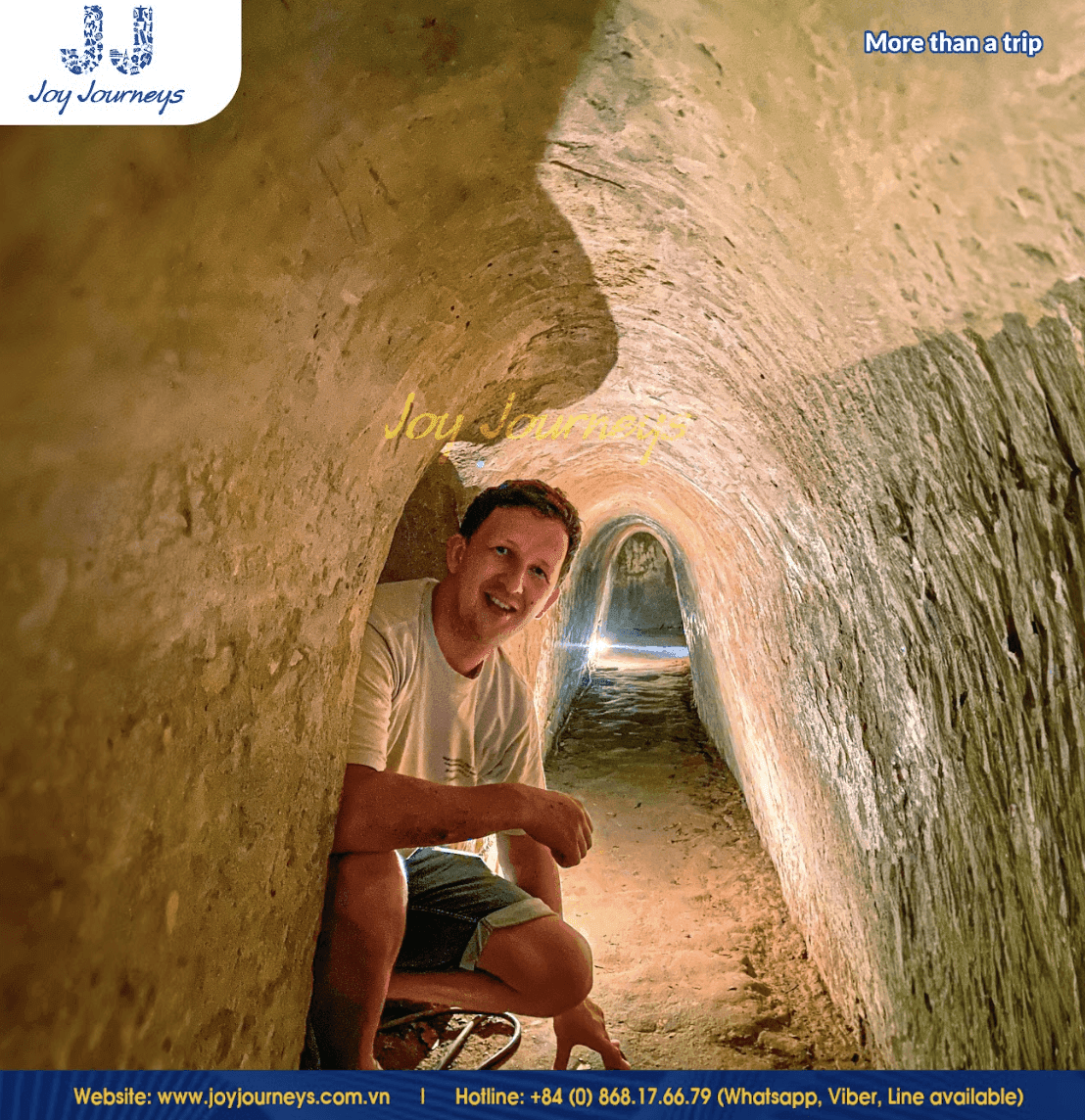The Cu Chi tunnels booby traps and artifacts offer a vivid look into the wartime strategies and survival tactics used during the Vietnam War. From concealed spikes to handmade weapons, these elements reveal the ingenuity behind this underground defense system. In this article, we explore the types of traps, preserved artifacts, and their historical significance.
Contents
- 1 Ingenious and Deadly: Inside the Cu Chi Traps Used in the Vietnam War
- 2 Types of Booby Traps Cu Chi Tunnels
- 3 Construction and Materials
- 4 Cu Chi Tunnels Artifacts on Display
- 5 Cu Chi Tunnels Weapons and Ammunition
- 6 Tools and Equipment
- 7 Personal Items
- 8 Safety and Preservation
- 9 Safe Display Methods
- 10 Preservation Efforts
- 11 Educational Value of the Cu Chi Tunnels History Tour
- 12 FAQs
- 13 Are the booby traps at Cu Chi Tunnels still active?
- 14 Can you touch the artifacts at the Cu Chi Tunnels?
- 15 Where are the artifacts stored and preserved?
- 16 What is the significance of these artifacts in understanding the Vietnam War?
Ingenious and Deadly: Inside the Cu Chi Traps Used in the Vietnam War
The Cu Chi traps represented a masterclass in asymmetric warfare, enabling Vietnamese fighters to counter the overwhelming technological and firepower advantages of American forces. Above ground, the area was densely packed with hundreds of cleverly disguised booby traps and fake bunkers, all designed to mislead and injure unsuspecting enemy soldiers. These traps weren’t just defensive measures; they were psychological weapons that created an atmosphere of constant fear and caution among American troops traversing the Cu Chi district.
What made these Vietnam War booby traps particularly effective was their dual purpose. Rather than being designed primarily to kill, many were intended to wound and maim, creating a significant drain on enemy resources. As one injured soldier would require the assistance of several others for evacuation and treatment, a single successful trap could effectively remove multiple fighters from combat operations.

Types of Booby Traps Cu Chi Tunnels
The types of booby traps Cu Chi tunnels contained were diverse and ingeniously crafted. Each was designed to exploit the terrain and maximize effectiveness with minimal resources:
Punji Stick Traps were among the most notorious weapons used by the Viet Cong. Constructed from sharpened bamboo or, at times, metal, these spikes were embedded in concealed pits of varying size and depth. Designed to impale anyone who fell in, the stakes were made even more dangerous by being coated with substances like urine, feces, or toxic plant matter to increase the risk of infection. Historical records estimate that punji stick traps were responsible for around 2% of injuries sustained by American soldiers during the war.
Swinging Door Traps were spring-loaded mechanisms equipped with metal spikes designed to strike an intruder’s torso when activated. As visitors to the tunnels today can see during demonstrations, these were particularly devastating as they could cause massive trauma to vital areas of the body.
The Mace, one of the most feared Viet Cong traps faced by US soldiers, was triggered by a tripwire. Once activated, a large metal or wooden ball with sharp spikes would swing down from a tree. This medieval-inspired device was particularly dangerous in situations where soldiers were moving in close quarters, as it could inflict severe injuries on multiple individuals at once.
Tiger Traps, similar to the mace, consisted of a weighted board embedded with sharp metal spikes. When a tripwire was triggered, it would release the catch on a rope, causing the plank to fall and strike the unsuspecting victim.
Cartridge Traps, also known as “Toe-poppers,” were clever devices that repurposed ammunition for deadly effect. These traps typically involved small arms cartridges, such as bullets, placed inside a bamboo tube over a nail and concealed in the ground with the tip exposed. When stepped on, the pressure from the foot would push the bullet onto the nail, igniting the primer and causing an explosion.
Revolving Trap Doors were one particularly clever design involving a rectangular pit with a revolving trap door and spikes at the bottom. The Viet Cong used this type of trap to injure their enemies. However, when they realized the traps were less effective against well-equipped American troops, they adapted their strategy. To increase the likelihood of infection, they began filling the pits with animal manure, making the wounds more dangerous.

Construction and Materials
The how did Cu Chi tunnels booby traps work question reveals impressive ingenuity in their construction. What stands out in historical accounts is the resourcefulness displayed in creating lethal weapons from readily available materials:
- Natural materials like bamboo were sharpened to create deadly spikes.
- Metal from unexploded American bombs and artillery shells was recycled into trap components.
- Simple mechanical principles like springs, counterweights, and pivots were employed to create triggering mechanisms.
- Local knowledge of the terrain was utilized to place traps where they would be most effective.
The trap construction reflected a profound understanding of the surrounding environment and demonstrated remarkable adaptability. When one approach proved ineffective, it was quickly modified. For example, when the Viet Cong discovered that American boots protected soldiers from simple spike traps, they began coating the spikes with animal excrement to cause infection in wounds.

Cu Chi Tunnels Artifacts on Display
Today, visitors seeing booby traps at Cu Chi tunnels gain insights into both the tactical and human dimensions of the conflict. The preservation of Cu Chi tunnels artifacts provides tangible connections to the past that books and documentaries alone cannot convey.
Cu Chi Tunnels Weapons and Ammunition
The Cu Chi tunnels weapons displays feature an array of armaments used by both sides during the conflict:
- American M16 rifles and other captured U.S. military equipment;
- AK-47s and other weapons used by Vietnamese fighters;
- Homemade weapons crafted from salvaged materials;
- Grenades, mines, and other explosive devices.
These displays help visitors understand the vast technological disparity between the opposing forces and highlight how Vietnamese fighters adapted to overcome these disadvantages.

Tools and Equipment
Beyond weapons, what artifacts are at Cu Chi tunnels includes tools and equipment that supported daily life and military operations in the tunnels:
- Primitive digging tools used to excavate the massive tunnel network
- Medical equipment from underground field hospitals;
- Communication devices;
- Cooking implements, including the famous Hoang Cam smokeless stoves;
- Ventilation systems that prevented detection.
These tools and equipment offer a powerful testament to the Viet Cong’s ability to create a self-sustaining underground world under extreme conditions. Their presence underscores how survival in the tunnels relied not only on military strategy but also on daily problem-solving, resourcefulness, and community effort.
Personal Items
Among the most poignant Cu Chi tunnels artifacts are the personal items belonging to those who lived and fought in the tunnels. These humanize the conflict and remind visitors that beyond the military tactics were individuals caught in extraordinary circumstances:
- Clothing and footwear;
- Handwritten letters and documents;
- Photographs;
- Personal hygiene items;
- Handcrafted items made during downtime.
These artifacts provide glimpses into the human experience of tunnel life, showing how people maintained some semblance of normalcy despite the harsh conditions.

Safety and Preservation
The presentation of Cu Chi tunnels booby traps and artifacts today balances educational value with visitor safety and artifact preservation.
Safe Display Methods
Modern displays at the Cu Chi Tunnels employ several techniques to safely demonstrate historical trap mechanisms:
- Clear barriers separating visitors from functional trap displays;
- Guided demonstrations by trained staff;
- Reconstructions that show functioning mechanisms without posing danger;
- Detailed diagrams and explanations accompanying physical exhibits.
This approach allows visitors to understand how these deadly devices functioned without risk.
Preservation Efforts
Maintaining these historical artifacts requires ongoing conservation work:
- Climate control to prevent deterioration of organic materials;
- Protection from humidity and insect damage;
- Careful documentation of each item’s provenance and historical context;
- Regular maintenance of display areas;
- Digital archiving for research purposes.
These preservation efforts ensure that future generations can continue to learn from these historical items and understand their significance in the broader context of the Vietnam War.
Educational Value of the Cu Chi Tunnels History Tour
The preservation of Cu Chi tunnels booby traps and artifacts serves a crucial educational purpose. By maintaining these tangible connections to history, the site helps visitors understand:
- The tactical ingenuity employed by Vietnamese forces;
- The psychological dimensions of guerrilla warfare;
- The lived experience of those who inhabited the tunnels;
- The broader historical context of the Vietnam War.
As visitors engage with these artifacts, they gain deeper insights into this complex conflict than would be possible through textbooks alone.

FAQs
Are the booby traps at Cu Chi Tunnels still active?
No, the booby traps displayed at the Cu Chi Tunnels today are not active. They have been carefully deactivated or reconstructed to demonstrate how they worked without posing any danger to visitors. Some are behind protective barriers, while others are demonstrations operated by trained guides. The entire site has been made safe for tourism while still preserving the educational value of seeing these historical devices.
Can you touch the artifacts at the Cu Chi Tunnels?
Visitors are generally advised not to touch artifacts at the Cu Chi Tunnels. This policy helps preserve these valuable historical items for future generations. Photography is generally permitted, though some areas may have restrictions.
Where are the artifacts stored and preserved?
The artifacts are primarily displayed in exhibition spaces throughout the Cu Chi Tunnels complex. Major artifacts are housed in dedicated areas at both the Ben Dinh and Ben Duoc sites. Some more sensitive or valuable items may be stored in climate-controlled facilities when not on display. The Vietnamese government, particularly through the Cu Chi Tunnels memorial management, oversees the preservation and curation of these historical items.
What is the significance of these artifacts in understanding the Vietnam War?
These artifacts provide invaluable insights into the asymmetric nature of the Vietnam War, demonstrating how a technologically disadvantaged force utilized ingenuity, local resources, and intimate knowledge of the terrain to counter a superior military power. The booby traps specifically reveal the psychological dimensions of the conflict, showing how creating fear and uncertainty among enemy troops was as important as causing casualties. Collectively, these artifacts challenge simplistic narratives about the war by highlighting the complexity of guerrilla tactics and the lived experience of those who fought using these methods.
Experience the Cu Chi Tunnels booby traps and artifacts up close and gain a deeper appreciation for their role in wartime survival. A Cu Chi Tunnels tour with Joy Journeys offers more than just sightseeing – it delivers expert storytelling and historical insight that bring the Cu Chi Tunnels history to life. Book your visit today to explore one of Vietnam’s most powerful war memorials with those who truly understand its legacy.
- Book directly at joyjourneys.com.vn
- Call us at +84 (0) 868.17.66.79
- Or email: inquiry@joyjourneys.com.vn
Let us help you craft a memorable journey into Vietnam’s wartime history!



Related Posts
Saigon’s “Flower Market Replica”: Where To Find Them
Ho Chi Minh City’s floral charm is not limited to its bustling wholesale markets. Imagine wandering through a place where vibrant petals, fragrant blooms, and the spirit of traditional Vietnamese markets come alive—without the overwhelming crowds. A flower market replica captures that magic, blending the beauty of fresh flowers with the charm of a curated, […]
Is it Safe to Travel to Vietnam Right Now? A Complete 2025 Guide
Vietnam has emerged as one of Southeast Asia’s most captivating destinations, drawing millions of visitors annually with its rich culture, stunning landscapes, and incredible cuisine. However, many travelers still ask: Is it safe to travel to Vietnam right now? This comprehensive guide provides you with everything you need to know about Vietnam travel safety in […]
Ho Chi Minh Cu Chi Tunnels Tour: The Ultimate Guide
The Cu Chi Tunnels stand as one of Vietnam’s most remarkable historical sites, offering visitors a profound glimpse into the ingenuity and resilience displayed during the Vietnam War. For travelers, a Ho Chi Minh Cu Chi tunnels tour represents an essential experience that combines education, adventure, and deep cultural understanding. This comprehensive guide will help […]